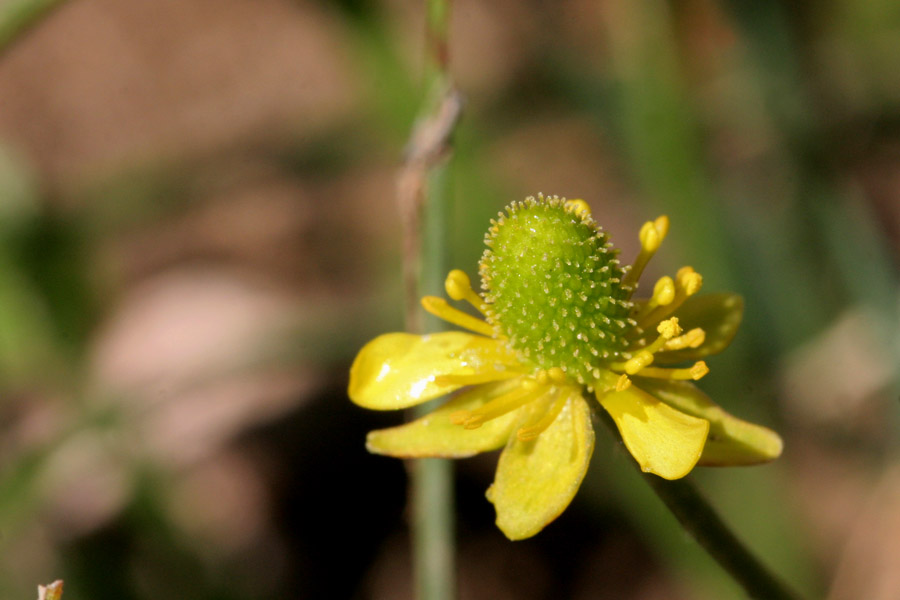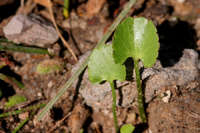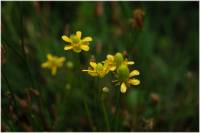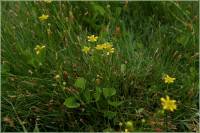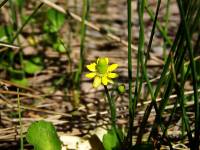|
Halerpestes cymbalaria (Pursh) Greene
 No occurrences found (redirected from: Ranunculus cymbalaria Pursh) |
|
|
Family: Ranunculaceae
alkali buttercup
[Cyrtorhyncha cymbalaria Britton, moreRanunculus cymbalaria Pursh, Ranunculus cymbalaria subsp. saximontanus (Fern.) Thorne, Ranunculus cymbalaria var. saximontanus Fernald] |
Stems dimorphic, flowering stems erect or ascending, stolons prostrate, rooting nodally, glabrous or sparsely hirsute, not bulbous-based. Tuberous roots absent. Basal leaves simple and undivided, blades oblong to cordate or circular, 0.7-3.8 × 0.8-3.2 cm, base rounded to cordate, margins crenate or crenate-serrate, apex rounded. Flowers: receptacle hispid or glabrous; sepals spreading, 2.5-6 × 1.5-3 mm, glabrous; petals 5, yellow, 2-7 × 1-3 mm. Heads of achenes long-ovoid or cylindric, 6-12 × 4-5(-9) mm; achenes 1-1.4(-2.2) × 0.8-1.2 mm, glabrous; beak persistent, conic, straight, 0.1-0.2 mm. 2 n = 16. Flowering late spring-summer (May-Sep). Bogs, marshes, ditches, stream banks, often saline Various Navaho groups used Ranunculus cymbalaria as a venereal aid, an emetic, and a ceremonial medicine. The Kawaiisu used it as a dermatological aid (D. E. Moerman 1986).
Glabrous, stoloniferous perennial, 5-15 cm tall; lvs mostly basal; petioles 2-5 cm; blades cordate-ovate to ovate or reniform, 5-25 mm, rounded above, usually cordate below, ±crenate; fls few; pet 3-5 mm, scarcely surpassing the sep; achenes longitudinally nerved, 1.5-2 mm, numerous in a short-cylindric head to 12 mm; 2n=16. May-Oct. In mud, especially in brackish or alkaline places; irregularly distributed throughout much of N. Amer., except se. U.S.; also in Asia. Our plants are var. cymbalaria. Gleason, Henry A. & Cronquist, Arthur J. 1991. Manual of vascular plants of northeastern United States and adjacent Canada. lxxv + 910 pp. ©The New York Botanical Garden. All rights reserved. Used by permission. FNA 1997, Welsh et al. 1993, Martin and Hutchins 1980, Kearney and Peebles 1969 Duration: Perennial Nativity: Native Lifeform: Forb/Herb General: Perennial from prostrate stolons that root at the nodes, glabrous or sparsely hirsute, vegetative stems erect or ascending, 0.5-1.5 mm wide, flowering stems 2-30 cm tall. Leaves: On petioles 1-15 cm long, basal leaves simple and undivided, 0.5-4 cm long by 0.8-3 cm wide, oblong to cordate or circular, base rounded to cordate, margins crenate to crenate serrate, with a rounded apex. Flowers: On pedicels 2-10 cm long, with 5 spreading sepals, 2.5-7.5 mm long, glabrous, deciduous, petals 5 or more, yellow, 2.5-8 mm long. Fruits: Head of achenes, long ovoid to cylindric 6-12 mm tall by 4-5 mm broad, the achenes about 1 mm, glabrous with a persistent beak that is conic and straight. Ecology: Found muddy sites of bogs, marshes, streambanks, and pools from 5,000-8,000 ft (1524-2438 m); flowers May-September. Notes: Distinguished by the cymbal-like leaves that are unlobed among the basal leaves with absent or highly reduced cauline leaves, along with the long pedicel for the flower and its stoloniferous nature. There still remains some question as to whether it has varieties. Ethnobotany: Used for syphilis, taken as a life medicine, the leaves were eaten, and used as a ceremonial emetic. Etymology: Ranunculus is from Latin rana, little frog, for the moist habit, while cymbalaria is from Greek kymbalon or Latin cymbalum for cymbal, referring to rounded leaf shapes. Synonyms: Numerous, see Tropicos Editor: SBuckley, 2010 |

